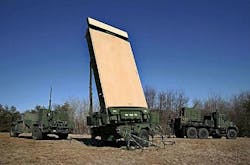Marines make transition from gallium arsenide to gallium nitride in air-defense radar
Officials of the Marine Corps Systems Command at Quantico Marine Base, Va., announced a $9.2 million contract modification Tuesday to the Northrop Grumman Electronic Systems segment in Linthicum Heights, Md., to insert gallium nitride components into the Ground/Air Task-Oriented Radar (G/ATOR).
The contract modification calls for Northrop Grumman experts to switch from gallium arsenide to gallium nitride-based electronics to help reduce costs of the expensive G/ATOR system, as well as to enhance its performance and reduce its weight and power consumption. The contract modification incorporates phase II of the gallium nitride transition of the G/ATOR low-rate initial production (LRIP) systems, Marine Corps officials say.
G/ATOR is an expeditionary, three-dimensional, short-to-medium-range multi-role radar system designed to detect low-observable targets with low radar cross sections such as rockets, artillery, mortars, cruise missiles, and UAVs.
Related: Latest order for Marine Corps G/ATOR radar systems brings total number of radars to six
Substituting gallium nitride electronic components for older gallium arsenide technology will help Northrop Grumman and the Marine Corps reduce the mass of the G/ATOR system without compromising its performance, officials say.
Reducing size, weight, and power consumption especially is important for the G/ATOR system because Marine Corps leaders plan to use the system on attack beaches to help defend Marine expeditionary forces from low-observable threats. The system must be sufficiently small and lightweight to accompany Marines in their initial land attacks.
On this contract modification Northrop Grumman will do the work in Linthicum Heights, Md., and should be finished by the end of 2016. For more information contact Northrop Grumman Electronic Systems online at www.northropgrumman.com, or Marine Corps Systems Command at http://www.marcorsyscom.marines.mil/.

